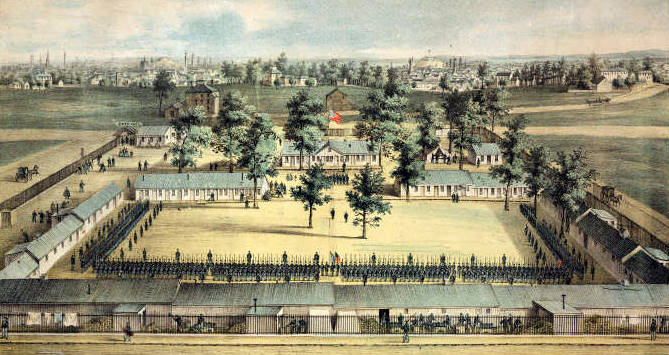The markings of Baltimore’s Civil War heritage are all around us, from downtown landmarks like President Street Station, to military buttons, ceramic ware, and bits of metal of every variety that lie literally under our feet. To help commemorate the 150th anniversary of the beginning of the Civil War this year, please join Baltimore Heritage and the Friends of West Baltimore Squares on July 9 as we dig into the history of Civil War-era Baltimore with an archeological investigation in Lafayette Square. We’re not sure what we’ll find under the topsoil, but we do know that the Square was the site of Lafayette Barracks during the civil war, a military camp and hospital that housed 1000 people strong. With support from the Archaeological Society of Maryland, the Maryland Historical Trust, and the local community, we are conducting an archaeological investigation of Lafayette Barracks, the military camp and hospital located in the park during the Civil War. Please stop by to talk to the archeologists, learn about urban archeology, and West Baltimore’s Civil War history. Throughout the afternoon, we will be offering walking tours, exhibits on the architectural history of the Square, and even grilled hotdogs!
Civil War Archeology in Lafayette Square
Saturday, July 9, 2011
Lafayette Square Park (West Lafayette Avenue & North Arlington Street)
11:00 AM to 3:00 PM
Tours, talks, and exhibits throughout the day and hotdogs at noon. On-street parking available. to look up directions, use 1100 W. Lafayette Avenue, Baltimore 21217.
RSVP Today!
From 1861 through 1865, as the United States were split by civil war, Lafayette Square in West Baltimore became a bustling military encampment and a rich scene of Baltimore’s Civil War life. Originally known as Camp Hoffman–named for Henry W. Hoffman, collector for the Port of Baltimore–the camp housed at least five Maryland Union regiments as well as troops from New York and other northern states. The Camp, including a hospital, sutler’s store, kitchen and parade grounds, served as a rendezvous point for Maryland and Delaware Union troops with as many as to 1,000 soldiers preparing for active duty at a time. In the blocks around the camp, one could find military bands marching down to Jarvis Hospital on Baltimore Street, drunken brawls at local bars between soldiers and civilians, deserters escaping through Druid Hill Park shot down by cavalrymen, and escaped slaves from the Eastern Shore taking refuge with Union troops before seeking freedom to the north. John Scharf, Baltimore’s foremost historian during the late 19th century, described Lafayette Square in 1865 as “filled with ugly wooden sheds, swarming with rough troops, while not one of the elegant mansions now surrounding it had been reared.”
Our archaeological investigation, led by archeologists Brandon Bies, MAA and Dr. David Gadsby, seeks to learn more about people who lived and worked at Lafayette Barracks during the Civil War by searching for any artifacts or surviving physical evidence that they left behind. With a dozen trained volunteers, our team will use metal detectors to search out metal artifacts, such as buttons or bullets, and open up a small area of excavation to search for the remains of Camp Hoffman. Stop by on July 9 to learn more about West Baltimore’s Civil War history and the process of historical archeology. We’ll be leading short walking tours every hour, sharing exhibits on the history and community of Lafayette Square, and hosting the Baltimore Civil War Museum with exhibits on archeology at President Street Station. Please RSVP if you’re planning to join us! Questions? Contact Eli Pousson at pousson@baltimoreheritage.org or 301-204-3337.


3 comments